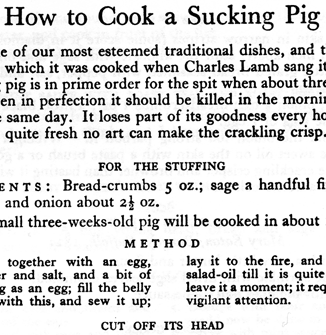Mind you crisp up the dead baby's ears, lest you be scolded
When an old friend sent a cry for help in dealing with the unexpected gift of a suckling pig, which he described unpoetically as "a dead baby in a cardboard box", the right thing to do was clear. I reached for Jane Grigson's Charcuterie and French Pork Cookery.
To achieve "beautiful crackling" on this "festival dish", Jane Grigson recommends basting with olive oil until the skin becomes croquante. In brief, her method calls for a lightweight stuffing of mirepoix and breadcrumbs. I would go heavy on the fennel seeds for a porchetta style. Regarding the presentation of the cochon de lait to table she notes wryly that:
Many cookery-book writers are anxious that the sucking pig be presented on the table with an American mortician's skill. 'Truss the legs and tail in a lifelike position, a small red apple in mouth and cranberries in the eye sockets. Try to preserve as nearly as possible the animal's original shape and form'.
Writing from personal experience, no doubt, Grigson warns:
But do not overemphasise these effects: few people have the robust constitutions required to look a small creature in its cranberry eye.
Next off the bookshelf was Good Things in England by Florence White, descriptively subtitled:
A Practical Cookery Book for Everyday Use
Containing Traditional and
Regional Recipes suited to
Modern Tastes contributed by
English Men and Women between
1399 and 1932...
William Kitchiner (1775-1827), the contributor of this recipe:
has different concerns where it comes to bringing the roast to the table:
Lay...the ears, one at each end, which you must take good care to make nice and crisp, or you will be scolded, as the good man was, who bought his wife a pig with only one ear.
So, apart from finding an oven large enough to accomodate your baby and finding some fellow diners with strong constitutions, the key -- as ever with pork roasts -- is attention to the crackling.
Bagsie an ear.
Anyone for ortolan? 7
I was given a copy of Simon Courtauld’s recent piece in The Spectator about the rarified gastronomy of ortolans. (Don’t bother trying to read it online; you can’t.)
A couple of facts cited in this entertaining piece about eating these tiny and highly prized birds puzzled me.
Apparently:
- it is common to put a napkin over your head whilst eating them
- the means of killing is often drowning in Armagnac
Larousse sheds light on the first:
Some gourmands cover their heads with their napkins while they are eating the birds so as to lose none of the aroma. The inventor of this ritual is a priest, a friend of the Brillat-Savarin family (citing James de Coquet)
It would be helpful if anyone can shed light on the Armagnac part.
Don’t bother asking your high-class butcher for ortolan. The birds are now protected and you will have to travel to France or Italy with your napkin if you want to eat one.
But before you go crazy with ortolan-envy, bear in mind Larousse’s warning that the bird:
is prized even more by those who know only the name than by those who have tasted it (citing Grimod de La Reyniere)
